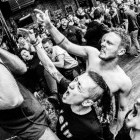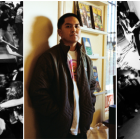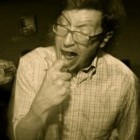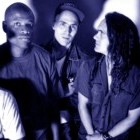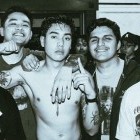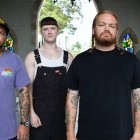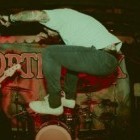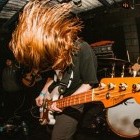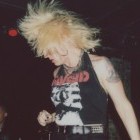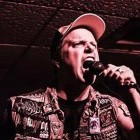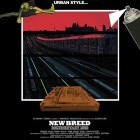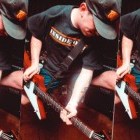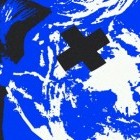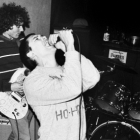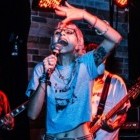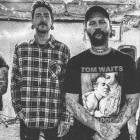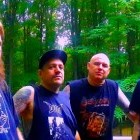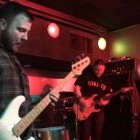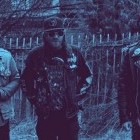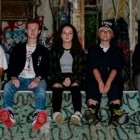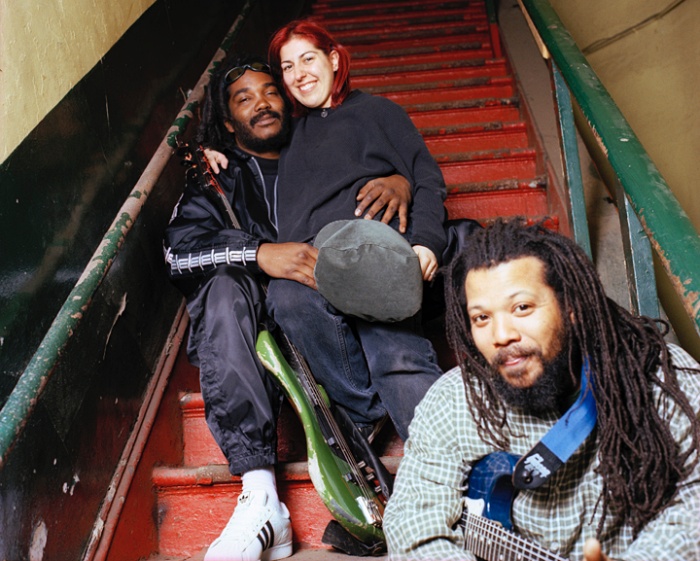
Since I've always been a liner notes junkie, when I first got into hardcore in the late '80s, I remember poring over record credits and seeing "photos by BJ Papas" over and over again. It didn't matter if it was Sick of It All rocking a hard pose in an alleyway for their first 7" or the guys in Killing Time standing on a fire escape somewhere in New York, it seemed like BJ was there to capture the moment. That's just the NYHC side of things, but she's worked with all kinds of bands throughout her career.
Based in Los Angeles these days, I spent an afternoon with her a couple of years back with my voice recorder for a No Echo interview. The problem is, when I went to transcribe the conversation, the audio was all fucked up. After trying to fix it on my own, I finally reached out to a music engineer friend who rescued the audio, albeit, after a long delay.
So, the road was a long one, but I'm psyched to share my interview with the one and only BJ Papas.
Even though you’ve lived here in Los Angeles for a long time now, I know you’re a fellow New York transplant. Where did you grow up?
I was born and raised in Woodstock, NY, and basically couldn’t wait to get out of there [laughs]. It’s funny because Gary [Miller, aka Dr. Know] and Darryl [Jenifer] of the Bad Brains live up there, now, and they’re both old friends. Anyway, the way I got out of Woodstock was by going to F.I.T. (Fashion Institute of Technology) in NYC for photography. I just wanted to be in NYC, so I got accepted into the program and in those two years, I lived in the dorms on 27th Street. I moved to Astoria, Queens around 1986. It’s a shame because if I would have lived there earlier, I wouldn’t have missed so many great shows.
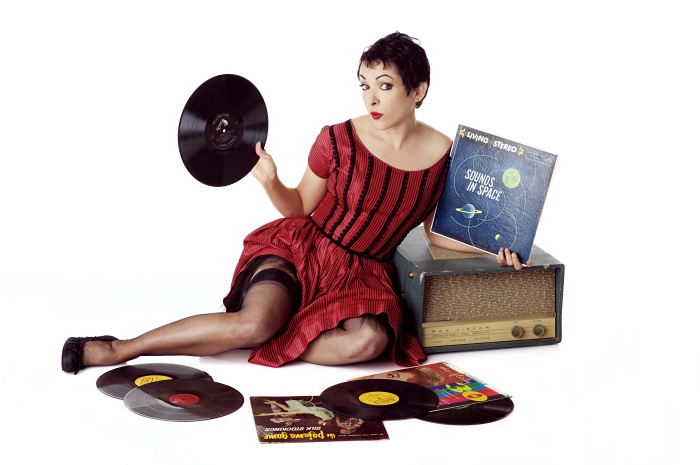
How did you come to discover punk and hardcore music?
When I was a kid and lived in Woodstock, there was there really cool record store there called The Collector. The owners were a couple, Lester and Pat, and whenever I would get my paycheck from this waitress job I had, I would go to their store. They had stuff like Dead Kennedys, Sex Pistols, etc. and all that. That was my exposure to it, but I don’t remember how exactly I discovered it. Before that, I was into bands like Van Halen and The Police. My brother listened to Pink Floyd, but I wasn’t into that stuff.
How did you come to meet folks from the local hardcore scene?
When I was still in college, I used to go to shows by myself. I remember going to a show at Irving Plaza and that’s when I met [NYC club bouncer] Big Charlie and he was giving me a hard time at the door and I was fighting back. Well, he thought that was funny because I’m 5-feet tall and he was 6-foot something. We ended up becoming great friends from there. I met Brendan Rafferty (vocalist of SFA) at that same show.
I remember we would drive to shows in Connecticut at the Anthrax, and shows that Dave Stein (Combined Effort Records) threw in Albany. I met a lot of people at those shows. My friend Wynn would drive us to a lot of shows back then. I thought it was stupid that Brendan joined the Army, so I started sending him photos to show him what he was missing [laughs]. Back then, you would get two prints of everything you developed, so I would send one to him, and the other I would give to the bands. The bands were always very thankful and then they would ask me to start shooting them. It all started that way.
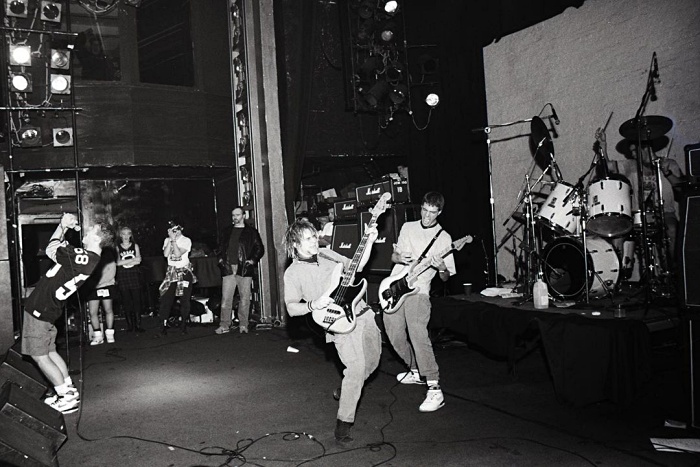
Who were some of the other photographers you remember seeing at those early hardcore shows?
Ken Salerno was definitely at a lot of shows. Frank White was at a lot of shows, (though he was more of a metal guy, right?) Wendy Eager was shooting those NYHC shows early on for her zine (Guillotine). Amy [Keim] from Nausea would shoot a lot of stuff like people from the scene hanging out and all that. Brooke Smith would do a lot of that kind of documentary stuff as well. Mo Browne would shoot stills and video. Definitely others but I can’t remember them all now.
Did you look up to specific music-related photographers back then?
I went to college to be a fashion photographer. But before that, my sister had suggested that I shoot bands, but I told her that I didn’t want to mix business with pleasure. It just ended up kind of happening that way. As far as specific people, Anton Corbijn is my all-time favorite photographer. Yeah, and I worked with him thanks to my friend, [film director, musician) Dito [Montiel]. Dito lived down the street from me in Astoria and he had a friend who knew Anton Corbijn’s rep, so I made these crazy Xerox’ed posters of Gutterboy, (which was Dito’s band at that time.) and in exchange I got Anton Corbijn’s rep’s phone number.
I ended up contacting his rep and every time I would call him, he would tell me that Anton wasn’t in town. This went on for a while, until I gave up and stopped calling. Finally one day, I get a call from his rep saying, “Do you know how many people with the name Pappas live in Astoria?!” [Laughs] I was like, “Yeah, there are a lot of Greek people in Astoria. But I spell Papas with 1 P” Anyway, he tracked me down and I finally got to meet and work with Anton because he was in town. He was shooting Depeche Mode, and I was lucky enough to assist him on that job. I was supposed to work with him again on a Lenny Kravitz shoot, but something fell through with that one. Bummer!
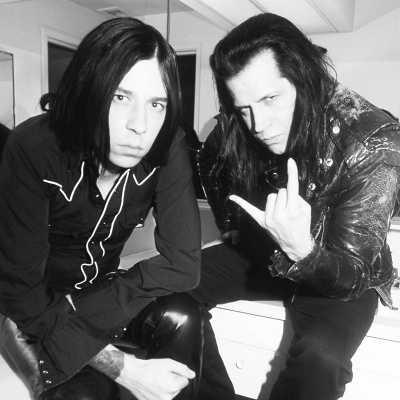
With hardcore shows being as wild they were back then, did you ever get injured while shooting a band?
I never got injured shooting a hardcore show. The only time I ever got hurt was at a Danzig show with the Cycle Sluts from Hell. I had to get stitches. It was at the Ritz and I got kicked in the side of my head by someone who was slamming behind me in the pit. I had to go to the hospital and I begged the doctor to hurry up so I could get back in time to shoot Danzig.That doctor got me back in time!
At shows back then, everyone was usually really nice and aware of me being there, so they would look out for me. People also danced better back then, meaning, they wouldn’t do things like go up and stage and wave their hands up like, “I made it up on stage, look at me!” Everyone danced with technique, and they did it because they loved the music, not to be a showoff.
Tell me about the iconic cover photo you took that ended up on the cover of the New York City Hardcore: The Way It Is compilation.
That was taken at the Anthrax in Connecticut. You could see Ray Cappo, Raybeez, Matt Warnke, and Gus Pena in the Schism t-shirt. [Laughs] We probably went to the show together. He also lived in Queens, like the Gorilla Biscuits guys, so we would all hop in a car and go to those faraway shows together. I didn’t shoot that show as an assignment, or anything. [Revelation Records owner] Jordan [Cooper] probably called me and asked if I had any Gorilla Biscuits shots. I would send negatives and people would pick shots they liked. I would have never picked that shot that is on that cover because I hate all of my pictures. I don’t remember much about that specific show or shot, to be honest.
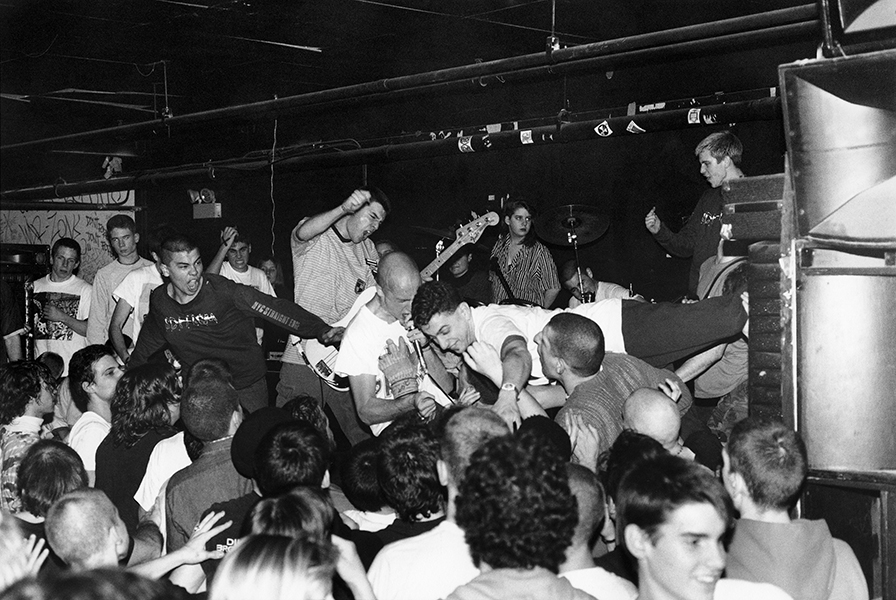
What’s the story behind the image on the cover of Bad Brains’ The Youth Are Getting Restless live album? I’ve always been intrigued with that image.
That’s Dr. Know playing his guitar, but I can’t remember what show that was taken from. Their manager Anthony County picked that one out. I never really liked shooting in color back then, so I was trying to get a long shutter in that one so it looked a bit more interesting than just using a flash. That’s probably why the guitar looks so crazy in that shot. The pattern in the background is Doc’s shirt [laughs]. It was like a tie-dye kind of thing.
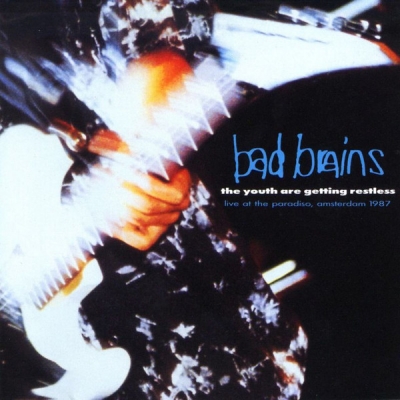
You’ve had a long history with the Bad Brains guys.
Yeah, I went out on a tour with Bad Brains, Sick of It All, and Leeway to California. Leeway were from Astoria, Queens so I rode with them. But we were all always together. The Bad Brains guys were always so nice to me. I remember there would be vegetarian food backstage for them and they would always offer me something to eat because I didn’t have any money [laughs].
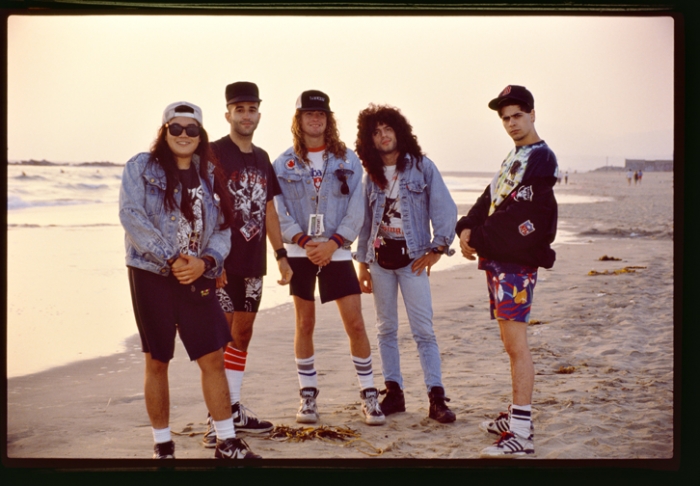
How about the photo on the Just Can’t Hate Enough album cover you did for Sheer Terror?
That was taken at CBGBs. I remember we specifically shot for the record, which was rare for me back then. I remember [Sheer Terror vocalist] Paul [Bearer] used to sit on my front stoop and crack me up! He’s such a character!
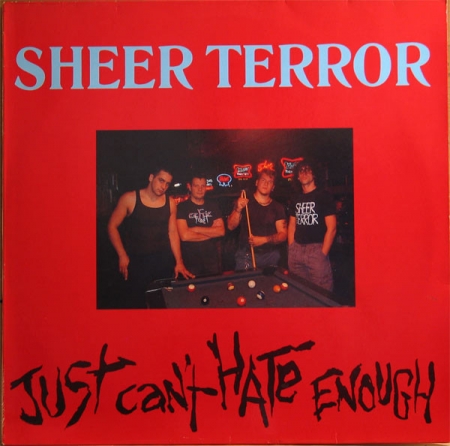
The back sleeve photo you shot of Killing Time for their Brightside LP has always been one of my favorite images from the NYHC scene. There’s something very NYC about it in its attitude. What’s the story behind that one?
This was another one where we shot it specifically for the record. They didn’t really like posing, so I remember trying really hard to get them positioned a certain way to capture the right light. We didn’t end up taking too many shots from them on that fire escape. Maybe 5 shots overall. I don’t even remember where we shot that photo. I do remember telling them to not look at me. Also, I usually took a long time, so they were probably annoyed by that point [laughs]. The hand-coloring was done by the record company (In-Effect Records). I believe Dave Bett (Sony Records) did it. Unfortunately, I don’t have any of the negatives for that shoot because the label never sent them back to me.
[After I interviewed BJ, I chatted with Anthony Drago of Killing Time and he said that the fire escape photo was taken at the Mamaroneck Playhouse movie theatre in Mamaroneck, NY.]
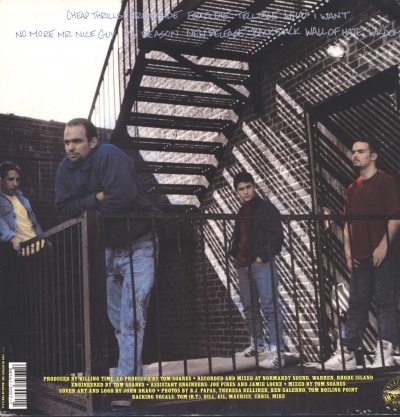
How about the photos for the Rest in Pieces Under My Skin album? Those are tough!
[Laughs] I remember being obsessed with cross-processing at that point. Anton Corbijn would cross-process a slide into a negative. That Rest in Pieces photo was cross-processing a negative into a slide. Not many people use that technique, but I liked it. I think that shot was taken somewhere in the Bronx. My favorite thing about [Rest in Pieces guitarist] Rob [Echeverria] back then was he would carry this pocket watch for style. So, no matter what, I would ask him several times during the day, 'What time is it?' [Laughs] I just wanted him to pull out the watch because it was so cool! He's great.
[I checked with Rob and he confirmed that the photos were taken at an abandoned housing project in the Bronx.]
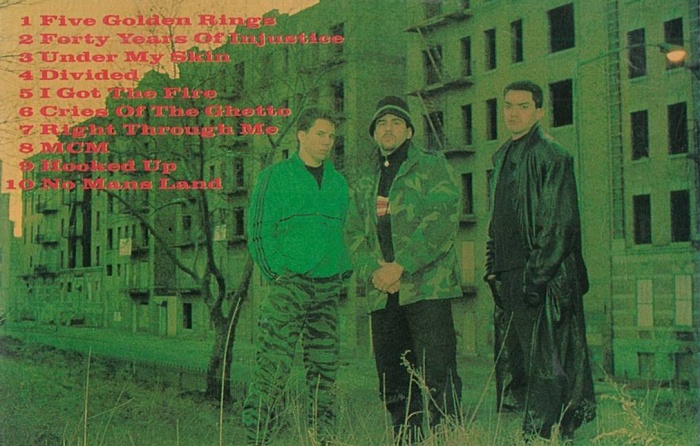
Tell me about this Madball photo where they’re playing cards. It’s obviously an outtake from the Demonstrating My Style album.
Yeah, that was done in my studio. It was fully staged. They liked the idea I had of them playing cards. A lot of people complain that those shots are blurry, but it was really grainy film that had really high grain resolution. It was so dark that it was tough for them to get it to come out, but it’s not blur, it’s grain.
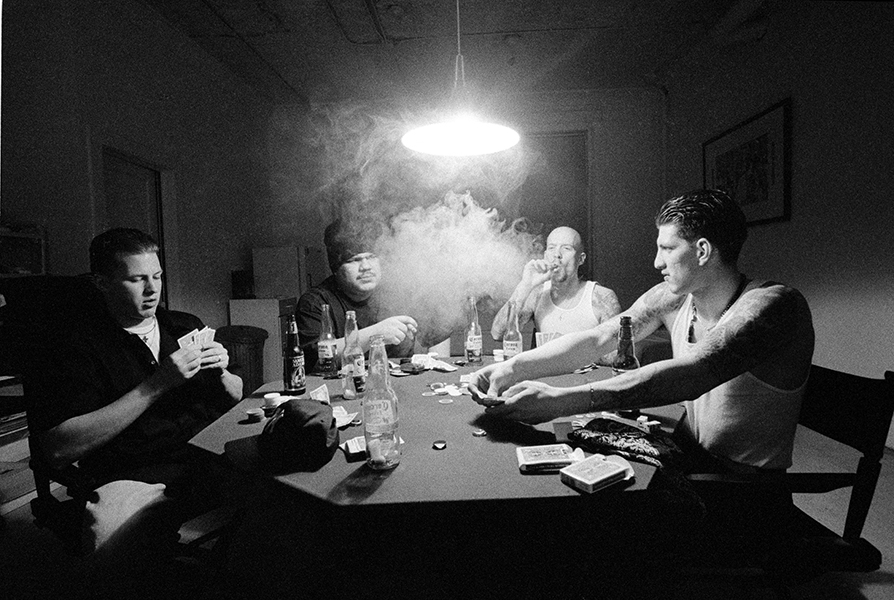
The photo you shot for Murphy’s Law’s Dedicated album is really cool. What’s the story behind those figures?
I’m pretty sure Uncle Al made them. They wanted me to photograph it like it was a real show. I did it at my photo studio and I gelled all of the lights to make it look like it was real. They made a figure of me with a camera, but I didn’t end up including it. I loved mine, but I was just to embarrassed to put myself on their cover. I love that you see Vinnie [Stigma] with his dog on there [laughs]. Those were so cool!
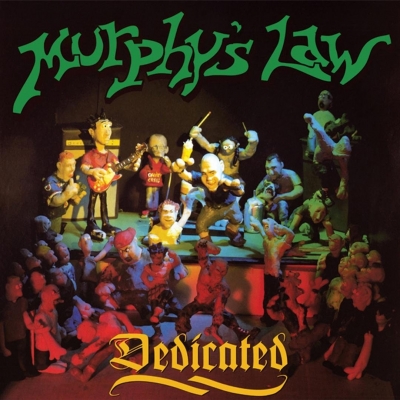
The classic Alleyway Crew photo you shot for Sick of It All used a fisheye lens, a style that would end up becoming really popular in hardcore circles and beyond.
Yeah, and that was a true fisheye lens, a 7.5. The lens was all glass and really big and heavy. I rented it for that shoot. I remember being up on a fence and looking down, and then telling the boys, ‘If you see my falling, please make sure you catch the lens’ because it was expensive [laughs]. Sick of It All were always the most fun to shoot with. The band asked me to shoot with the fisheye lens.
Another thing people might find interesting is that the shot was done in the actual alleyway in Queens that inspired them to call themselves the Alleyway Crew.
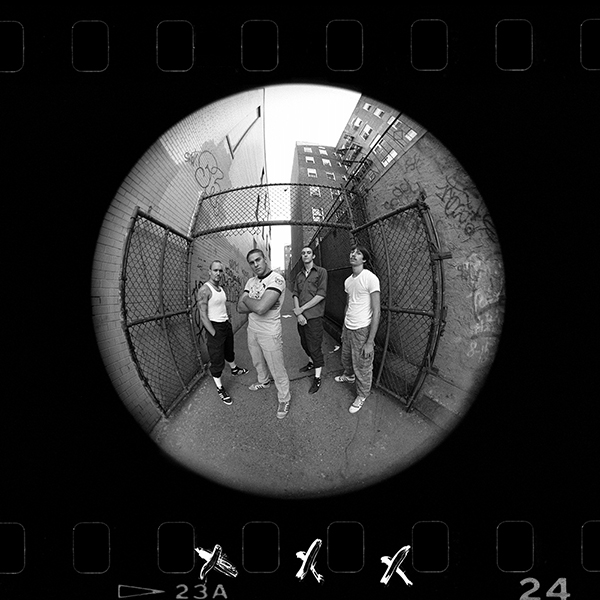
Where did you take this H20 photo where they’re in the beauty shop?
Moon [Morse] worked at Beauty Bar in NYC at the time, so she hooked that location up. I had the guys just hang out and read magazines. [Laughs] Toby was always on the phone back then so we thought it would be funny if he read the Yellow Pages.
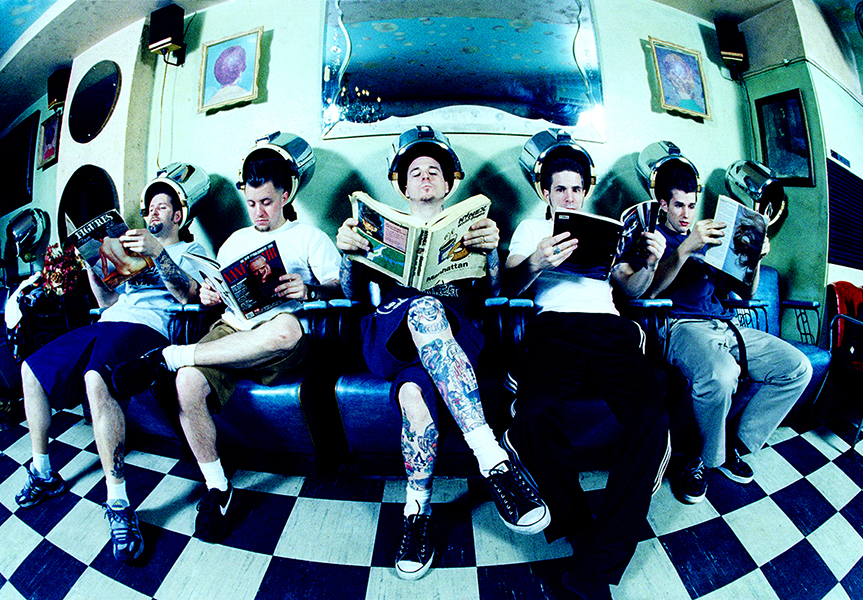
I love the chest piece shot of Roger Miret you took back in 1991.
So, Amy [Keim] had usually shot Agnostic Front, but she didn't want to shoot them anymore. She wanted to focus on documentary type stuff, but still wanted to keep it in the family, so she asked me to do it. I remember shooting that behind Vinnie Stigma's apartment in Little Italy. You can see the brick in the background.
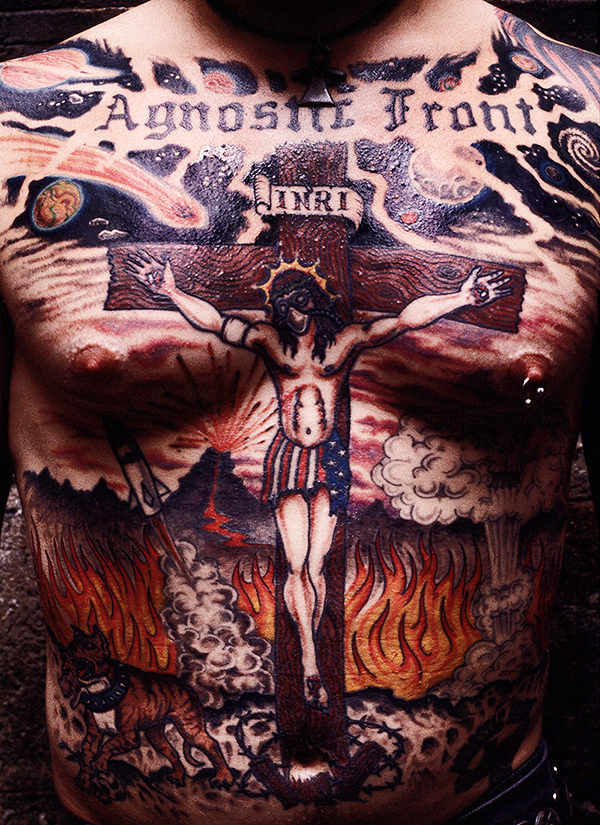
How about this Bouncing Souls photo of them on the stoop?
I feel bad about that one because I had just gotten a studio on Spring Street and was really into shooting bands there. Bands usually don’t like shooting in a studio setting, and that Bouncing Souls photoshoot came out awful. I was so embarrassed! Anyway, I called them up and apologized and offered to shoot them again so that we could get something that makes everyone happy.
I figured shooting them with their bmx's would work since they loved riding. They just were riding their bikes all around the city and I shot all day. That one was shot somewhere in the Lower East Side. I’m really happy that they gave me a second chance on that because, like I said, I felt so bad about the studio one. It just wasn’t “them” I’m glad in the end we were all happy with the outcome.
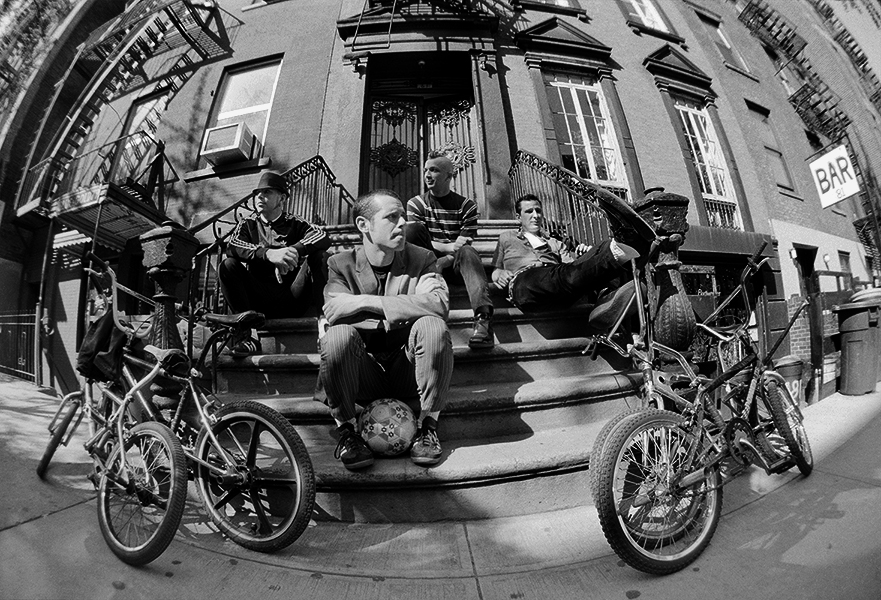
This one of Joe Strummer is another cool shot.
Thanks, yeah, that was a shoot I did with Joe for Guitar World magazine. I remember I had to wait for him to finish a bunch of other shoots that day, but we went to a bar afterwards. I remember that it was just when the smoking ban happened in NYC. He went to go light a cigarette and the waiter told him there was no smoking allowed. Well, Joe flipped him off. So, what you see in that shot is the moment that happened. It was not staged. [Laughs] He lit up anyway, because he’s Joe Strummer.
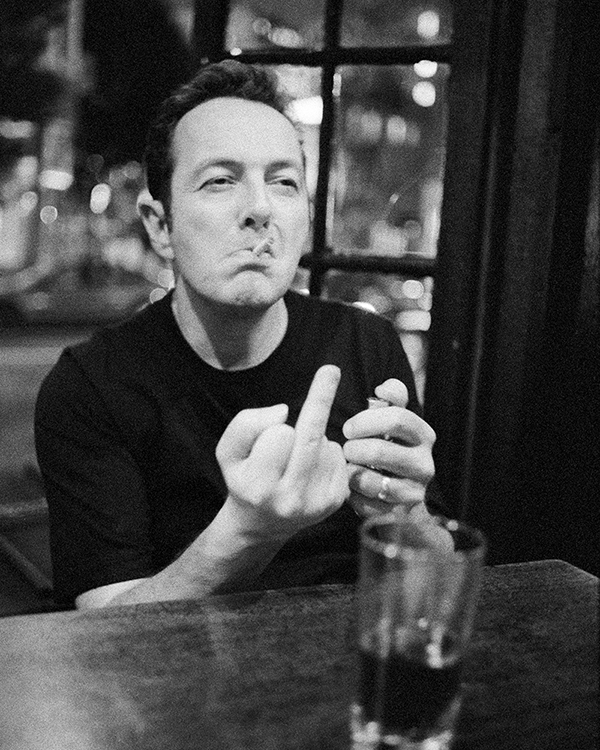
I wanted to ask you about the Mike Ness photo because he’s not someone I see many candid shots of.
That was when I first moved to LA and it was shot at the Wiltern. I was backstage with Mike and he told me had to go and put his makeup on. I asked if it would be OK if I came along to shoot some photos and he was cool with it. It wasn’t shot for a particular magazine or anything. I just love Social Distortion.
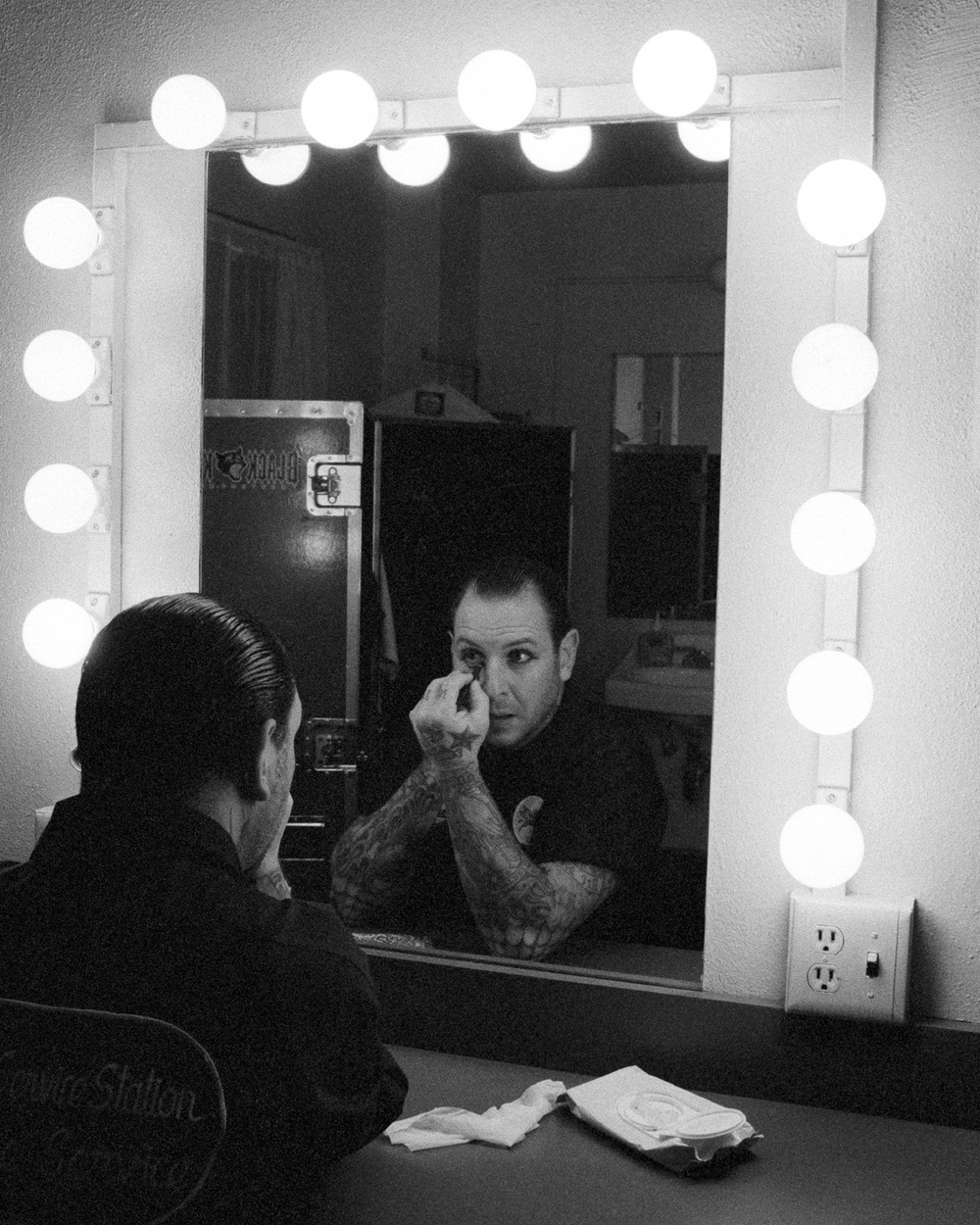
What's the story behind this Warzone photo from 1987?
That was when [Youth of Today vocalist] Ray [Cappo] and [Warzone singer] Raybeez were putting on shows at the Pyramid Club. That was taken at that club. They look like babies there [laughs].
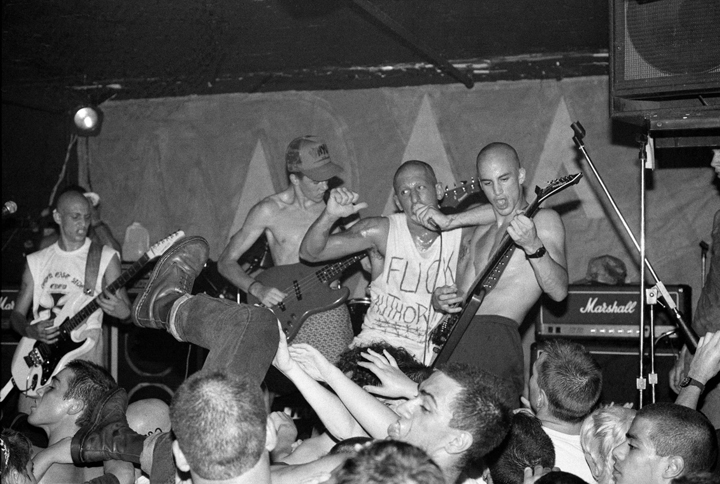
Lastly, what's the story behind this pic of Tim Armstrong from Rancid? I've definitely seen it around the web for years now.
[Laughs] Oh yes, I didn't know Tim at that point. I wanted to see Rancid and the show had been sold out. Somone ended up getting me into the show and I got on stage and started shooting. So, I didn't know if I had pissed him off or not, but I decided to keep on shooting and find out later. Anyway, I gave him the photo and he loved it. We've been best friends ever since then. I love Tim.
I used to shoot Rancid a lot and at one point I had a cane because I had gotten hit by a taxi in NYC. Well, I was shooting a Rancid show during that time and it took me so long to get from one side of the stage to the other that I wouldn't make it in time, so a song would end and another would start while I was in the middle of the stage [laughs]. The Rancid guys would make fun of me.
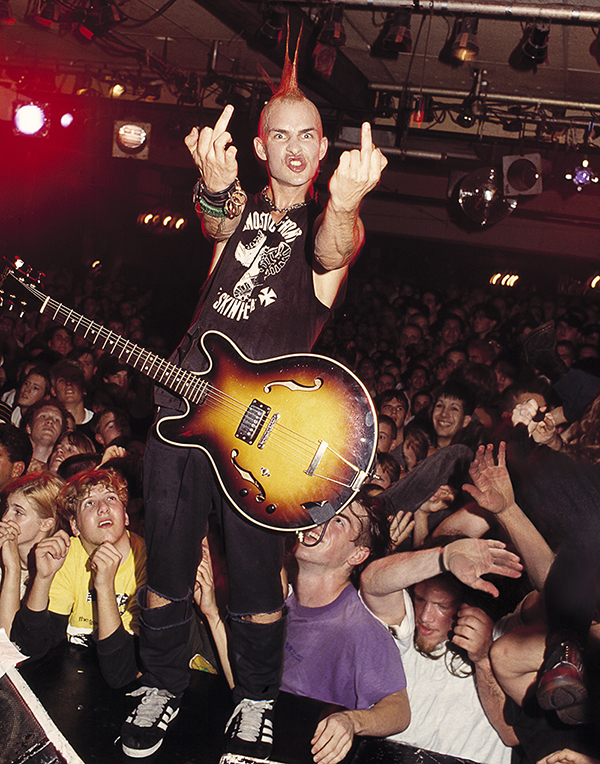
There was also a show where some girl asked me if I was [Rancid singer/guitarist] Lars' [Frederiksen] mom because she saw me taking photos of Rancid on stage while I was using the cane [laughs]. She thought because we both had blonde spiked hair I must be his mom. So, I brought her backstage and asked her to tell Lars what she had just told me. Everyone was cracking up [laughs]. To this day, I'm "Lars' mom" when I see those guys.
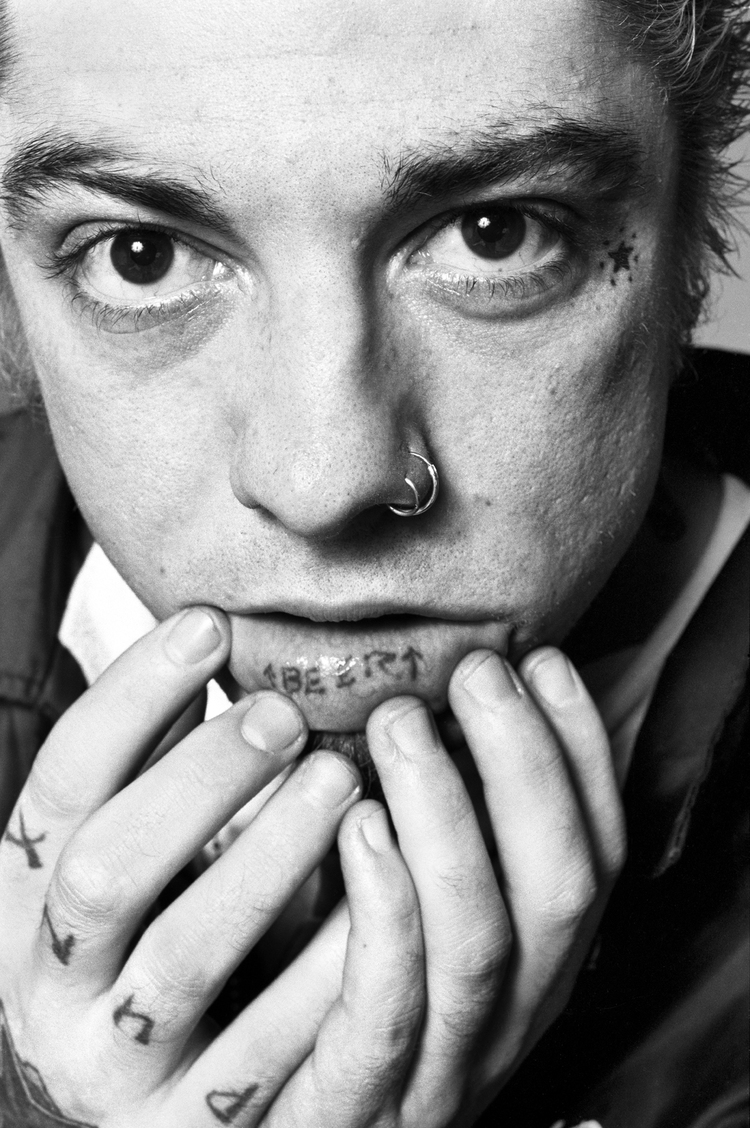
***
Head to BJPapas.com to see more of her work. BJ is also on Instagram, so make sure you follow her there.

